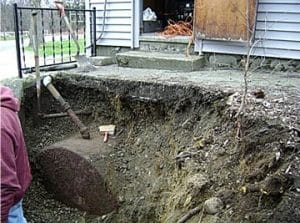 Contributed by Mike Luckett, Senior Engineer, PPM Consultants
Contributed by Mike Luckett, Senior Engineer, PPM Consultants
Underground Storage Tanks (USTs) are often found by surprise during construction projects of all types. These are often referred to as orphan tanks or abandoned tanks. The methods of handling these can vary extensively between states based on local rules and regulations. Some states have no prescribed methods only interpretive regulations from which to discern a path forward. Louisiana has a stepwise process that is presented below.
The first step is to determine if the tank is registered. This would be done by looking up the location on Louisiana Department of Environmental Quality (LDEQ) Electronic data Management System (EDMS).
If the tank is registered, follow the procedures in the Underground Storage Tank Closure/ Change-In-Service Guidance Document which include:
- changing the tank registration to the name of the current property owner using the UST Registration Form
- submitting a notice of intent to close the tank)
- cleaning the tank
- collecting appropriate samples from the native soil and backfill during tank removal;
- and removing the tank for disposal.
If hydrocarbon impact is found, investigation and remediation of the impact may be eligible for reimbursement under the Louisiana Motor Fuels Trust Fund.
A final report should be submitted to LDEQ following the guidelines in the closure document and including the UST Closure Assessment Form
If the tank is not registered, the first step is to determine if there is any evidence of a release from the tank. First, attempt to determine what may have been stored in the tank to determine appropriate sampling parameters. Most of the orphan tanks that are found contained either gasoline, diesel, or oil (new or used). However, if you cannot narrow it down to one of these uses based on historical knowledge or obvious context, samples will have to be analyzed for the full slate of volatile organic compounds (VOC), semi-volatile organic compounds (SVOC), metals, and total petroleum hydrocarbons (TPH) to verify there is no residual impact to the subsurface from the tank contents.
 Orphan tanks were often abandoned in place by filling with sand, in which case during closure the sand should be sampled as well for the same parameters to determine appropriate disposition of the sand. If the tank is full of water or other fluids, the fluids will have to be sampled for the same parameters before removal to determine appropriate disposition of the fluids.
Orphan tanks were often abandoned in place by filling with sand, in which case during closure the sand should be sampled as well for the same parameters to determine appropriate disposition of the sand. If the tank is full of water or other fluids, the fluids will have to be sampled for the same parameters before removal to determine appropriate disposition of the fluids.
If there is no evidence of impact, the tank can be removed for recycle and no notice to LDEQ is required.
If there is impact, you will have to register the tank for closure and conduct a proper closure according to the guidance document as outlined above.
Following this process will insure that any orphan tanks found on your property will be handled correctly. If you have any questions about dealing with orphan tanks in Louisiana or another state, please feel free to reach out to me at mike.luckett@ppmco.com.

